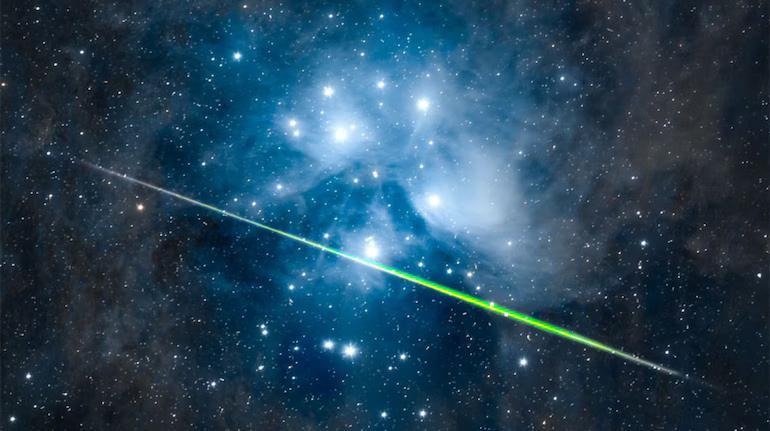
Pic Shows Blazing Meteor Crossing Pleiades Cluster in Saudi Skies
On a recent clear night in Saudi Arabia, a spectacular event lit up the skies, capturing the attention of NASA astronomers and stargazers alike. A blazing meteor, also known as a shooting star, crossed the iconic Pleiades star cluster (M45), producing a stunning green glow that has left many in awe.
The Pleiades star cluster is one of the most recognizable and beloved celestial bodies in the night sky. Located approximately 444 light-years away from Earth, this open star cluster is a treasure trove of celestial wonders, comprising over 1,000 stars. The cluster’s bright blue color is due to the scattering of light by the surrounding blue-reflecting dust.
NASA astronomers were in the midst of photographing the Pleiades star cluster with long exposures to reveal the bright stars and surrounding blue-reflecting dust when the unexpected meteor streaked across the frame. The fast-moving rock fragment, estimated to be about the size of a basketball, produced a striking green glow due to the vaporization of metals.
The resulting photograph, captured by NASA’s Picture of the Day program, has left many fascinated by the sheer beauty and rarity of this event. The meteor, which was traveling at a speed of approximately 40,000 miles per hour, left a glowing trail that stretched across the frame, adding an extra layer of drama to the already breathtaking scene.
The Pleiades star cluster is a popular target for astronomers and astrophotographers due to its proximity to Earth and relatively simple equipment requirements. The cluster’s seven brightest stars, known as the “Pleiades sisters,” are named for the seven daughters of the Titan Atlas in Greek mythology. These stars are Alcyone, Atlas, Electra, Maia, Merope, Taygeta, and Celaeno, named after the mythological figures.
Meteor showers occur when the Earth passes through a trail of debris left behind by a comet or asteroid. These particles, known as meteoroids, enter the Earth’s atmosphere, burning up and producing the bright streaks of light we commonly refer to as shooting stars. However, the meteor that crossed the Pleiades star cluster was a rare and isolated event, not related to any known meteor shower.
The NASA Picture of the Day program is a daily feature that showcases the agency’s most stunning and captivating images of the solar system and beyond. The program aims to inspire and educate the public about the wonders of space exploration and the vastness of the universe.
In conclusion, the photograph of the blazing meteor crossing the Pleiades star cluster in Saudi skies is a testament to the awe-inspiring beauty and complexity of the universe. This rare and unexpected event has left many in wonder, and serves as a reminder of the many wonders waiting to be discovered in the vast expanse of space.






